Tokyo 2020: 20 works of Japanese art
Posted on by Fay Curtis.
by Amy Raphael, Project Curator of Japanese Ceramics
The Tokyo 2020 Summer games may be over, but you can still enjoy Japanese culture here at Bristol Museum & Art Gallery.
We look back on the events of the Olympic and Paralympic games and pair them with 20 works of Japanese art from our collection.
No spectators
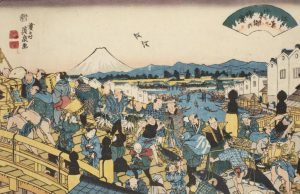
In the midst of a global pandemic, Tokyo 2020 was a Summer Olympics like no other. There were no spectators or tourists allowed and Tokyo was quieter than anticipated. The bustling scene in this print from the 1840s shows people crossing Nihonbashi bridge in the heart of Edo, old Tokyo.
Look closely and you can find traders carrying fresh fish, vegetables, and people pushing a heavy cart loaded with barrels of sake, rice wine. In the distance is the military ruler’s castle and Mount Fuji.
Athletes arriving

In the days leading up to the Olympic and Paralympic games, teams of athletes arrived at Haneda airport with all their gear.
We were reminded of this print by Hiroshige showing the changing of horses and porters at Fujieda, the twenty-second station along the Tokaidō Road, the main road that connected Kyoto to Edo, old Tokyo.
I wonder if the travellers in this print were headed to Tokyo too?
Fireworks and drones
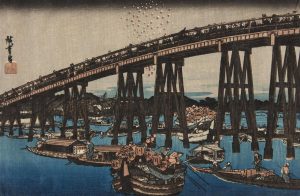 Perhaps the most dramatic moment of the Olympic Opening Ceremony was the fireworks and drones.
Perhaps the most dramatic moment of the Olympic Opening Ceremony was the fireworks and drones.
Fireworks are traditionally held in the summer in Japan. They were a very frequent evening entertainment during the Edo period. They became so popular that by the mid-seventeenth century the threat of fires led authorities to issue decrees restricting the use of fireworks on the Sumida river in Edo, old Tokyo.
Parade of Nations
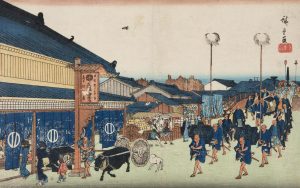 This print of a procession through Edo looks as if it could be showing the Parade of Nations.
This print of a procession through Edo looks as if it could be showing the Parade of Nations.
It actually depicts the mandatory ‘alternate attendance’ of feudal lords, who were required to alternate living for a year in Edo and a year in the domain they ruled. Their wife and children lived in Edo, essentially as hostages.
Martial Arts
 Martial arts have a long history in Japan and this year’s events were held in the Nippon Budokan.
Martial arts have a long history in Japan and this year’s events were held in the Nippon Budokan.
The arena was built for the Tokyo 1964 games when judo first debuted as an Olympic sport.
At first glance this dish may seem unrelated to martial arts but it is in fact a pun.
In Japanese, ‘grapes and squirrels’, budō ni risu, sounds like ‘the discipline of martial arts’, budō ni rissu.
Swimming
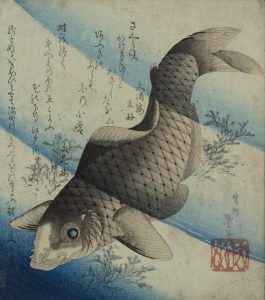 In swimming, Great Britain won eight medals in the Olympic events and twenty-six medals in the Paralympic events.
In swimming, Great Britain won eight medals in the Olympic events and twenty-six medals in the Paralympic events.
The ripples in this print by Katsushika Taito II (active 1810-1853), a pupil of Katsushika Hokusai (1760-1849), give the impression of a carp swimming against the current.
In Japan, a carp swimming upstream symbolises perseverance and the overcoming of obstacles.
Sailing
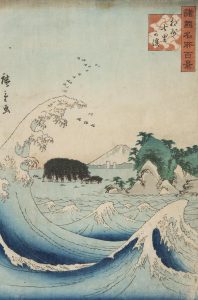 The Olympic sailing competitions took place in Enoshima at Enoshima Yacht Harbour, to the southwest of Tokyo. This woodblock print by Andō Hiroshige (1797-1858) shows the same harbour 162 years ago.
The Olympic sailing competitions took place in Enoshima at Enoshima Yacht Harbour, to the southwest of Tokyo. This woodblock print by Andō Hiroshige (1797-1858) shows the same harbour 162 years ago.
Framed by the wave is the forest-covered Enoshima island and the snow-capped peak of Mount Fuji in the distance.
Football
 Holding a ball in its paws, this shishi lion looks as though it is ready to play a game of football.
Holding a ball in its paws, this shishi lion looks as though it is ready to play a game of football.
Pairs of lion statues guard the entrances of temples and shrines in Japan.
In the open mouth of this netsuke carving is a loose ball that appears and disappears when the netsuke is moved.
Running
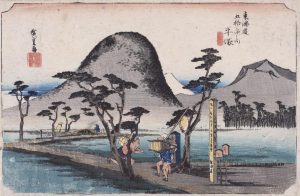 Look closely in this print by Hiroshige and you can see a figure running in the landscape.
Look closely in this print by Hiroshige and you can see a figure running in the landscape.
This person is a hikyaku, a courier who ran long distances to deliver letters, documents and packages across Japan.
That is one very athletic postman!
Canoeing
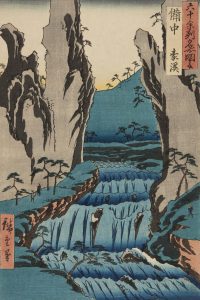 Oh to canoe down the rapids in this Hiroshige print…
Oh to canoe down the rapids in this Hiroshige print…
From the series Famous Views of the Sixty-odd provinces, this print shows the Makidani river coursing through Gokei valley, a place famous for its strange rock formations.
Wrestling
 This netsuke carving shows a fisherman wrestling with an octopus. The fisherman’s expression suggests that he knows he is in trouble.
This netsuke carving shows a fisherman wrestling with an octopus. The fisherman’s expression suggests that he knows he is in trouble.
He pulls on the octopus’ nose – how effective would that be?
Skeet shooting
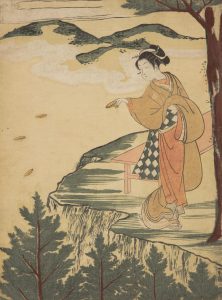 In skeet shooting, shooters hit a moving clay target.
In skeet shooting, shooters hit a moving clay target.
This woodblock print by Suzuki Harunobu (1724-1770) shows a woman throwing clay dishes over a cliff in a religious ritual that is said to be effective in getting rid of misfortune.
I wonder if that is how the clay targets are thrown in the Olympic event?
Equestrian
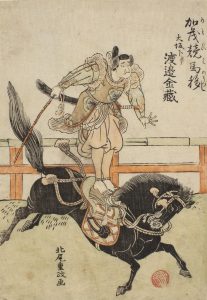 With five medals in the Olympics and eight in the Paralympics, Great Britain won a total of thirteen medals in the Tokyo 2020 equestrian events.
With five medals in the Olympics and eight in the Paralympics, Great Britain won a total of thirteen medals in the Tokyo 2020 equestrian events.
This print by Shigemasa Kitao (1739-1820) shows Kinzo Watanabe performing in a circus in Osaka. It looks like it was quite the performance!
Track Cycling
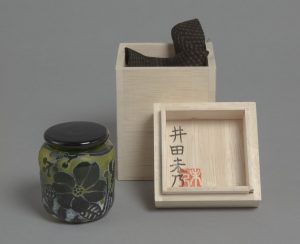 The track cycling took place at Izu Velodrome. Izu is located in Shizuoka Prefecture, a place known for growing green tea.
The track cycling took place at Izu Velodrome. Izu is located in Shizuoka Prefecture, a place known for growing green tea.
This glass tea caddy was made in Izu in 2016 by the artist Mino Ida (b. 1969). It is decorated with the wild flowers and foliage local to the western Izu area.
Artistic swimming
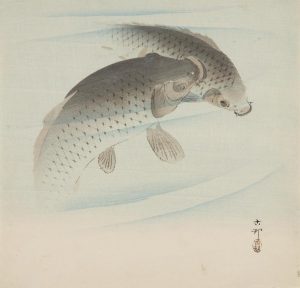 Bristol duo Kate Shortman and Izzy Thorpe did a brilliant job representing Team GB in the artistic swimming.
Bristol duo Kate Shortman and Izzy Thorpe did a brilliant job representing Team GB in the artistic swimming.
These two koi carp by Koson Ohara (1877-1945) don’t seem to be as synchronised…
Fencing
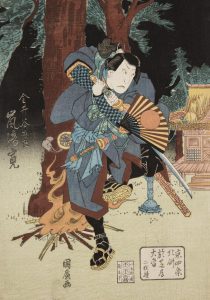 ParalympicsGB won a total of five medals in the wheelchair fencing.
ParalympicsGB won a total of five medals in the wheelchair fencing.
It may not be fencing, but this print shows the kabuki actor Arashi Rikan playing the role of Kanai Yagorō drawing his sword for a fight on stage.
Road Cycling
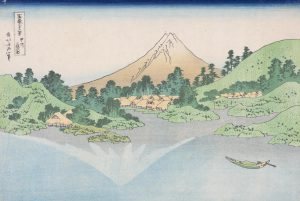 The road cycling races took place in the foothills of Mount Fuji at Fuji Speedway.
The road cycling races took place in the foothills of Mount Fuji at Fuji Speedway.
This Hokusai (1760-1849) print shows a reflection of Mount Fuji in Lake Misaka. Look closely and you will see that the reflection is different from the mountain. Together, the two Fuji mountains represent summer and winter.
Badminton
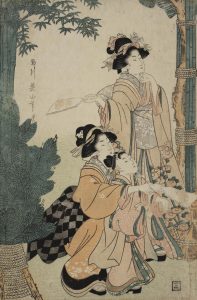 Have you heard of the game hanetsuki? It is a Japanese game similar to badminton that is traditionally played at the New Year.
Have you heard of the game hanetsuki? It is a Japanese game similar to badminton that is traditionally played at the New Year.
The objective of the game is to keep the shuttlecock in the air – the longer it stays in the air, the more luck one has in the coming year!
Congratulations
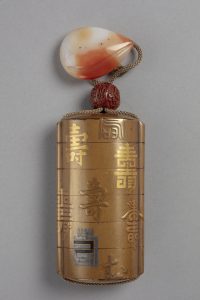 Inrō were used for carrying small personal items such as medicines, stamp seals, and coins.
Inrō were used for carrying small personal items such as medicines, stamp seals, and coins.
This golden inrō is aptly decorated with the Japanese word for ‘congratulations’ in different fonts – congratulations athletes!
Farewell
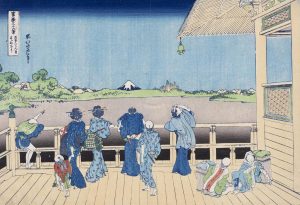 As the Tokyo 2020 Summer Olympics come to an end, we wave goodbye to Japan.
As the Tokyo 2020 Summer Olympics come to an end, we wave goodbye to Japan.
__
We have many Japanese objects on display at Bristol Museum & Art Gallery, come in and have a look! Our exhibition Netsuke: Miniature Masterpieces from Japan is on display at Bristol Museum & Art Gallery until 5 June 2022.
Visit our online exhibitions on Japanese woodblock prints, netsuke carvings, and haiku poetry.